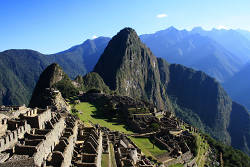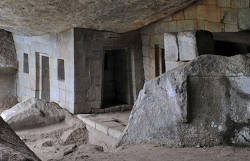Temple of the Moon
Templo de la Luna - Quilla
Useful Information


| Location: | At Machu Pic’chu, department of Cusco, in the Urubamba province and district of Machupicchu. From Aguas Calientes bus shuttle. From Machu Pic’chu climb through the left side of the Huayna Pic’chu Mountain. 1 h climb. (13º 7′ S, 72° 35′ W) |
| Open: |
All year daily 6:30. [2008] |
| Fee: |
free. [2008] |
| Classification: |
 Cave Church, Cave Church,
 tectonic cave tectonic cave
|
| Light: | bring torch. |
| Dimension: | A=2,350 m asl. |
| Guided tours: | |
| Photography: | allowed |
| Accessibility: | no |
| Bibliography: | |
| Address: | |
| As far as we know this information was accurate when it was published (see years in brackets), but may have changed since then. Please check rates and details directly with the companies in question if you need more recent info. |
|
History
| 6th century | Temple of the Moon built. |
| 1300 | Initial period, first buildings errected. |
| 1300 | Classic period. |
| 1533 | Imperial period. |
| 1572 | Transition period. |
| JUL-1909 | Machu Pic’chu visited by the Santander brother |
| 24-JUL-1911 | official rediscovery by Yale University professor Hiram Bingham. |
| 1936 | Temple of the Moon discovered. |
Description


The Templo de la Luna (Temple of the Moon) is an Inca building inside a cave on Huayna Pic’chu near Machu Pic’chu. The name was given to the building by an archaeologist with too much imagination, or it is arbitrarily named, like many of the sites in Peru. Most likely it was just because the temple at Machu Pic’cu was alread named after the sun, and so the moon was the next logic thing. Actually we have no idea what it is. Most likely it was not even a ceremonial temple. Some say it served as an observation point, to watch if any intruder might take some of the oblations. As caves and springs were thought to be entrances for gods, the cave was probably a place of worship for the mountain and its Gods. There is also a theory that the cave once contained mummies, again without any archaeological evidence.
But we can at least describe it. The cave contains a building which is 8 m high and 6 m wide. Its form is rectangular and it has three doors which are 1.60 m wide. It was built from large cuboid stone blocks that were placed on top of one another without mortar. They have been processed so precisely that they join together almost seamlessly. There is no inside, the doors and windows are fake and end after a meter. The temple is surrounded by other buildings which are partly collapsed. In the center of the cave is a throne carved out of rock, steps beside the throne lead deeper into the cave
Machu Pic’chu is considered to be from the 15th century. The Temple of the moon is estimated to be 1,500 years old, or from the 6th century, which makes it substantially older. It predates the Inca.
The city Machu Pic’chu does not exist, the city we know under this name was named Patallaqta and quite unimportant and that’s the reason why it was not destroyed. Its purpose and even its name is lost in time, and so we name it after one of the mountains, where it was built: Machu Pic’chu. On the other end of the village is Huayna Pic’chu, and that’s where the cave is located, on the northern side of the mountain, 390 m below the summit. Its a rather small cave, formed by a huge boulder which collapsed and created the hollow when it came to rest. Such caves are called tectonic caves.
The temple is not part of the normal visit to Machu Pic’chu. Only 400 visitors are permitted here per day to avoid destruction. If you want to go there you have to pay an additional fee and climb on Huayna Pic’chu. The way is not dangerous but exposed, surefootedness and a head for heights, as well as a certain physical fitness are absolutely necessary. One of the things you have to do is climb a longer wooden ladder. And as the visit takes time you probably have to organize this with your tour organizer.

|
| Gallery |
 Search DuckDuckGo for "Temple of the Moon"
Search DuckDuckGo for "Temple of the Moon" Google Earth Placemark
Google Earth Placemark Machu Pic’chu’s Enigmatic “Temple Of The Moon” (visited: 01-AUG-2020)
Machu Pic’chu’s Enigmatic “Temple Of The Moon” (visited: 01-AUG-2020) Index
Index Topics
Topics Hierarchical
Hierarchical Countries
Countries Maps
Maps